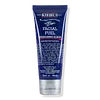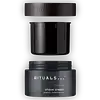What's inside
What's inside
 Key Ingredients
Key Ingredients

 Benefits
Benefits

 Concerns
Concerns

 Ingredients Side-by-side
Ingredients Side-by-side

Water
Skin ConditioningMyristic Acid
CleansingPalmitic Acid
EmollientPerlite
AbsorbentPotassium Hydroxide
BufferingLauric Acid
CleansingStearic Acid
CleansingPEG-7 Glyceryl Cocoate
EmulsifyingPrunus Armeniaca Seed Powder
AbrasiveDisodium Cocoyl Glutamate
CleansingGlycerin
HumectantSodium Lauroyl Glutamate
Phenoxyethanol
PreservativeCeteareth-60 Myristyl Glycol
EmulsifyingSodium Hydroxide
BufferingArgilla
AbrasiveCitric Acid
BufferingSodium Cocoyl Glutamate
CleansingCaprylyl Glycol
EmollientPentaerythrityl Tetra-Di-T-Butyl Hydroxyhydrocinnamate
AntioxidantDisodium EDTA
Parfum
MaskingMenthol
MaskingCaffeine
Skin ConditioningLimonene
PerfumingGlycine Soja Oil
EmollientTocopherol
AntioxidantCastanea Sativa Seed Extract
Skin ConditioningPentylene Glycol
Skin ConditioningHydrolyzed Soy Protein
HumectantCitrus Aurantium Dulcis Juice
Skin ConditioningCitrus Limon Juice
Skin ConditioningSodium Benzoate
MaskingPotassium Sorbate
PreservativeEthylhexylglycerin
Skin ConditioningWater, Myristic Acid, Palmitic Acid, Perlite, Potassium Hydroxide, Lauric Acid, Stearic Acid, PEG-7 Glyceryl Cocoate, Prunus Armeniaca Seed Powder, Disodium Cocoyl Glutamate, Glycerin, Sodium Lauroyl Glutamate, Phenoxyethanol, Ceteareth-60 Myristyl Glycol, Sodium Hydroxide, Argilla, Citric Acid, Sodium Cocoyl Glutamate, Caprylyl Glycol, Pentaerythrityl Tetra-Di-T-Butyl Hydroxyhydrocinnamate, Disodium EDTA, Parfum, Menthol, Caffeine, Limonene, Glycine Soja Oil, Tocopherol, Castanea Sativa Seed Extract, Pentylene Glycol, Hydrolyzed Soy Protein, Citrus Aurantium Dulcis Juice, Citrus Limon Juice, Sodium Benzoate, Potassium Sorbate, Ethylhexylglycerin
Water
Skin ConditioningHelianthus Annuus Hybrid Oil
EmollientCetearyl Alcohol
EmollientGlycerin
HumectantCoco-Caprylate/Caprate
EmollientGlyceryl Stearate
EmollientMyristyl Myristate
EmollientButyrospermum Parkii Butter
Skin ConditioningStearic Acid
CleansingPalmitic Acid
EmollientParfum
MaskingPhenoxyethanol
PreservativeSodium Stearoyl Glutamate
CleansingBiosaccharide Gum-1
HumectantGuar Hydroxypropyltrimonium Chloride
Skin ConditioningXanthan Gum
EmulsifyingPanax Ginseng Root Extract
EmollientBisabolol
MaskingOcimum Basilicum Oil
MaskingTocopherol
AntioxidantButylene Glycol
HumectantSodium Chloride
MaskingCoumarin
PerfumingLimonene
PerfumingCitronellol
PerfumingEthylhexylglycerin
Skin ConditioningOctenidine Hcl
AntimicrobialLactic Acid
BufferingCitric Acid
BufferingWater, Helianthus Annuus Hybrid Oil, Cetearyl Alcohol, Glycerin, Coco-Caprylate/Caprate, Glyceryl Stearate, Myristyl Myristate, Butyrospermum Parkii Butter, Stearic Acid, Palmitic Acid, Parfum, Phenoxyethanol, Sodium Stearoyl Glutamate, Biosaccharide Gum-1, Guar Hydroxypropyltrimonium Chloride, Xanthan Gum, Panax Ginseng Root Extract, Bisabolol, Ocimum Basilicum Oil, Tocopherol, Butylene Glycol, Sodium Chloride, Coumarin, Limonene, Citronellol, Ethylhexylglycerin, Octenidine Hcl, Lactic Acid, Citric Acid
Ingredients Explained
These ingredients are found in both products.
Ingredients higher up in an ingredient list are typically present in a larger amount.
Citric Acid is an alpha hydroxy acid (AHA) naturally found in citrus fruits like oranges, lemons, and limes.
Like other AHAs, citric acid can exfoliate skin by breaking down the bonds that hold dead skin cells together. This helps reveal smoother and brighter skin underneath.
However, this exfoliating effect only happens at high concentrations (20%) which can be hard to find in cosmetic products.
Due to this, citric acid is usually included in small amounts as a pH adjuster. This helps keep products slightly more acidic and compatible with skin's natural pH.
In skincare formulas, citric acid can:
While it can provide some skin benefits, research shows lactic acid and glycolic acid are generally more effective and less irritating exfoliants.
Most citric acid used in skincare today is made by fermenting sugars (usually from molasses). This synthetic version is identical to the natural citrus form but easier to stabilize and use in formulations.
Read more about some other popular AHA's here:
Learn more about Citric AcidEthylhexylglycerin (we can't pronounce this either) is commonly used as a preservative and skin softener. It is derived from glyceryl.
You might see Ethylhexylglycerin often paired with other preservatives such as phenoxyethanol. Ethylhexylglycerin has been found to increase the effectiveness of these other preservatives.
Glycerin is already naturally found in your skin. It helps moisturize and protect your skin.
A study from 2016 found glycerin to be more effective as a humectant than AHAs and hyaluronic acid.
As a humectant, it helps the skin stay hydrated by pulling moisture to your skin. The low molecular weight of glycerin allows it to pull moisture into the deeper layers of your skin.
Hydrated skin improves your skin barrier; Your skin barrier helps protect against irritants and bacteria.
Glycerin has also been found to have antimicrobial and antiviral properties. Due to these properties, glycerin is often used in wound and burn treatments.
In cosmetics, glycerin is usually derived from plants such as soybean or palm. However, it can also be sourced from animals, such as tallow or animal fat.
This ingredient is organic, colorless, odorless, and non-toxic.
Glycerin is the name for this ingredient in American English. British English uses Glycerol/Glycerine.
Learn more about GlycerinLimonene is a fragrance that adds scent and taste to a formulation.
It's found in the peel oil of citrus fruits and other plants such as lavender and eucalyptus. The scent of limonene is generally described as "sweet citrus".
Limonene acts as an antioxidant, meaning it helps neutralize free radicals.
When exposed to air, oxidized limonene may sensitize the skin. Because of this, limonene is often avoided by people with sensitive skin.
The term 'fragrance' is not regulated in many countries. In many cases, it is up to the brand to define this term. For instance, many brands choose to label themselves as "fragrance-free" because they are not using synthetic fragrances. However, their products may still contain ingredients such as essential oils that are considered a fragrance.
Learn more about LimonenePalmitic Acid is a fatty acid naturally found in our skin and in many plant and animal sources. In cosmetics, it is usually derived from palm oil. It serves many purposes in skincare, acting as a cleanser, emollient, and emulsifier.
As an emollient, palmitic acid helps soften and smooth the skin by preventing water loss. In cleansers, it helps remove oil and dirt while creating foam.
Its emulsifying properties help stabilize products by keeping water and oil-based ingredients from separating.
This may not be suitable for fungal acne-prone skin, as fatty acids like this can sometimes trigger breakouts in sensitive individuals.
Learn more about Palmitic AcidParfum is a catch-all term for an ingredient or more that is used to give a scent to products.
Also called "fragrance", this ingredient can be a blend of hundreds of chemicals or plant oils. This means every product with "fragrance" or "parfum" in the ingredients list is a different mixture.
For instance, Habanolide is a proprietary trade name for a specific aroma chemical. When used as a fragrance ingredient in cosmetics, most aroma chemicals fall under the broad labeling category of “FRAGRANCE” or “PARFUM” according to EU and US regulations.
The term 'parfum' or 'fragrance' is not regulated in many countries. In many cases, it is up to the brand to define this term.
For instance, many brands choose to label themselves as "fragrance-free" because they are not using synthetic fragrances. However, their products may still contain ingredients such as essential oils that are considered a fragrance by INCI standards.
One example is Calendula flower extract. Calendula is an essential oil that still imparts a scent or 'fragrance'.
Depending on the blend, the ingredients in the mixture can cause allergies and sensitivities on the skin. Some ingredients that are known EU allergens include linalool and citronellol.
Parfum can also be used to mask or cover an unpleasant scent.
The bottom line is: not all fragrances/parfum/ingredients are created equally. If you are worried about fragrances, we recommend taking a closer look at an ingredient. And of course, we always recommend speaking with a professional.
Learn more about ParfumPhenoxyethanol is a preservative that has germicide, antimicrobial, and aromatic properties. Studies show that phenoxyethanol can prevent microbial growth. By itself, it has a scent that is similar to that of a rose.
It's often used in formulations along with Caprylyl Glycol to preserve the shelf life of products.
Stearic Acid is a fatty acid. It is an emollient, emulsifier, and texture enhancer.
As an emollient, stearic acid helps soften skin. It aids the skin's protective barrier by preventing water loss. It also provides a gentle cleansing effect without stripping away natural oils.
Stearic acid may also be used to enhance the texture of products. It can add volume and stabilize ingredients such as water and oil. This can help water and oil ingredients from separating.
Sources of stearic acid include animal or vegetable fats/oils such as coconut or shea. It can be naturally found in butter, cocoa butter, shea butter, vegetable fats, and animal tallow.
This ingredient may not be Malassezia folliculitis, or fungal-acne safe.
Learn more about Stearic AcidTocopherol (also known as Vitamin E) is a common antioxidant used to help protect the skin from free-radicals and strengthen the skin barrier. It's also fat soluble - this means our skin is great at absorbing it.
Vitamin E also helps keep your natural skin lipids healthy. Your lipid skin barrier naturally consists of lipids, ceramides, and fatty acids. Vitamin E offers extra protection for your skin’s lipid barrier, keeping your skin healthy and nourished.
Another benefit is a bit of UV protection. Vitamin E helps reduce the damage caused by UVB rays. (It should not replace your sunscreen). Combining it with Vitamin C can decrease sunburned cells and hyperpigmentation after UV exposure.
You might have noticed Vitamin E + C often paired together. This is because it is great at stabilizing Vitamin C. Using the two together helps increase the effectiveness of both ingredients.
There are often claims that Vitamin E can reduce/prevent scarring, but these claims haven't been confirmed by scientific research.
Learn more about TocopherolWater. It's the most common cosmetic ingredient of all. You'll usually see it at the top of ingredient lists, meaning that it makes up the largest part of the product.
So why is it so popular? Water most often acts as a solvent - this means that it helps dissolve other ingredients into the formulation.
You'll also recognize water as that liquid we all need to stay alive. If you see this, drink a glass of water. Stay hydrated!
Learn more about Water